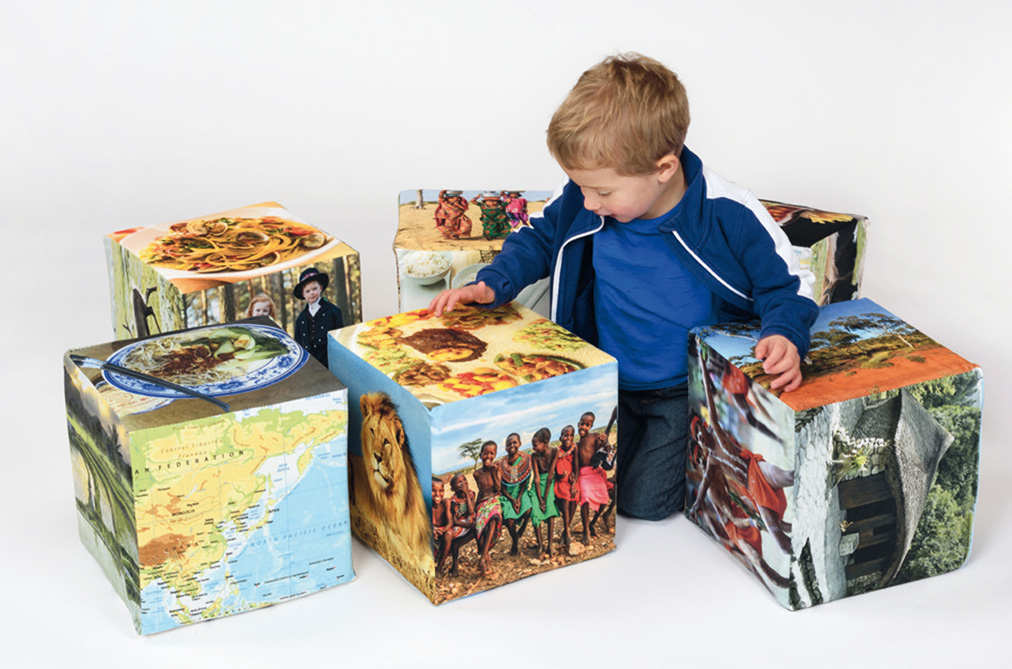
iSandbox
Company: iSandbox
Price: £5,750
Age range: 2-8 years
Website: www.isandbox.co.uk
This interactive sandbox uses augmented reality to transform a traditional sandpit into realistic 3D textures of water, mountains, volcanoes, snow and many other objects. A unique interactive software program, projector and depth measuring sensor work together to transform the sandpit into magical proportions. It is coupled with beautiful music, the sounds of nature and unique graphics.
Testers described it as a ‘wow’ piece of learning equipment which is attractive, engaging, calming, inclusive and lots of fun. The children were fascinated by the different colours and the background noises and music. They were communicating with each other, copying each other and jumping up and down with excitement. iSandbox lets lava flow, oceans swirl, grass grow and bubbles blow. It helps children learn about colours and numbers and how to draw and explore their surroundings. Children testing it found the games entertaining and exciting. They learn and play at the same time, which makes it not only educational but also fun.

Woodland, Safari and Polar Footprints
Company: Yellow Door
Price: £54
Age range: 2 years-plus
Website: www.yellow-door.net
This set of ‘Let's Investigate’ animal footprint stones, from a variety of habitats, is a fantastic resource to inspire young children in their investigative play. Tactile and robust, these double-sided stones will prompt talk and exploration of the natural world and are designed to be enjoyed outdoors, in water, sand or mud. They prompted lots of discussion about animals around the world and the marks they made, and in one setting the children enjoyed stacking, counting and sorting them into size order.

TickiT Domestic Animal Family Match

Company: Commotion
Price: £19.99
Age range: from 12 months
Website: www.commotion.co.uk
A set of 14 detailed photographic images of real animal adults and their young which are colour printed on beech plywood tiles. They are useful for promoting discussions about where animals live, what they eat and what eats them, where children can see or visit them, and the differences between the adults and their young. Children enjoyed arranging them and they independently discussed the animals in the pictures, stating which they had at home.
Practitioners discussed the names of adults and babies and the children then went on to group them in their families. In one setting, it provided an opportunity to use technology to look up the name of baby animals. Children initiated games such as ‘pairs’ with them, and they paid close attention to detail, especially with the animals they had at home.


TickiT Wild Animal Family Match
Company: Commotion
Price: £19.99
Age range: from 12 months
Website: www.commotion.co.uk
Children at the tester settings enjoyed discussing the sounds that the wild animals make with this set of 28 images printed on beech plywood square tiles. They also spent a lot of time independently playing with the animals, adding stories and characters to their small-world play.
Playing with the animals prompted discussion about size and change over time, and comparing this with human growth. Over time, practitioners thought that they could discuss wider topics such as predators, what dangers the animals face from each other, the environment or from humankind.

TickiT Wooden Minibeast Blocks
Company: Commotion
Price: £49.99
Age range: from 12 months
Website: www.commotion.co.uk
These chunky wooden picture blocks, colour printed on both sides with real images of minibeasts from around the world, were well-received in tester settings. Children enjoyed naming the minibeasts that they already knew and learning the names of the ones that they didn't know. Because they are free-standing, they can be used in imaginative play, and children were reported to spend a lot of time independently playing with the animals, adding stories and characters to their small-world play.
Children also made homes for them out of leaves and grass to keep them safe. Following on from this, it opened up discussion about bug behaviour; how and what they eat; what eats them; if they undergo metamorphosis; and the habitats they live in. They also helped with developing descriptive language skills and learning about the characteristics of a wide range of different creatures.


TickiT Fruit and Vegetable Match
Company: Commotion
Price: £19.99
Age range: from 12 months
Website: www.commotion.co.uk
Fourteen pairs of smooth, tactile beech plywood tiles, colour printed with photographic images of real fruit and vegetables. These are chunky enough for small hands to grip, rotate and turn over. Testers commented that they were versatile and could be used with different age groups.
Two-year-olds pointed out their favourite fruits and vegetables but were not able to match the cut version to the whole version of the fruit. Children aged 30 months and over understood that when fruits are cut, they look different. Other testers commented on how children enjoyed arranging and sorting them, using them for memory or matching games, and for learning about the colourful world of healthy eating.

Culture Cubes
Company: Millwood Education
Price: £239
Age range: 3 years-plus
Website: www.millwoodeducation.co.uk
This set of six 30cm squared foam cubes each show five different aspects of cultures from around the world and a map of the area on the sixth side. Testers found them useful for developing an understanding of the world and encouraging discussions relating to different cultures including food, people, habitats, farming and climate.
The children involved in the review were able to discuss the differences and similarities in the people in the pictures and relate them back to their own lives. The material is soft, and the children enjoyed stacking them and using them as seats.

‘The images on the cubes are lovely and the children enjoyed speaking about them. They were able to spot similarities and differences and relate these to their own lives’




